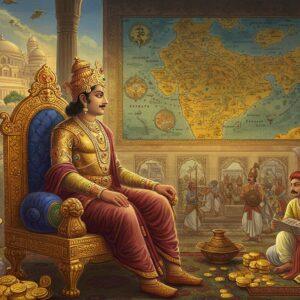
Navadvipa, nestled in West Bengal, India, holds a revered position in the tapestry of Vaishnavism, particularly the Gaudiya Vaishnava tradition. This sacred land is deeply connected to ancient scriptures like the Vedas, Puranas, and the Mahabharata, echoing tales of Lord Krishna. Its significance is amplified by its association with Sri Chaitanya Mahaprabhu, a pivotal figure in Vaishnava history, who was born there. This exploration delves into the rich history, core teachings, and lasting influence of Navadvipa Vaishnavism.
Historical Background
Navadvipa’s emergence as a Vaishnava hub began in medieval Bengal (around the 15th century). It blossomed into a renowned center of theological discourse and spiritual learning. The socio-political climate of the time nurtured religious scholarship, supported by local rulers and patrons who fostered these practices. This era witnessed vibrant debates and the exchange of ideas, solidifying Navadvipa’s reputation as a hub for spiritual and intellectual growth. Over time, Navadvipa Vaishnavism spread across India and eventually gained global recognition. Today, its scriptures and practices continue to be cherished and observed by numerous devotees worldwide.
Explore a Complete History of Hinduism at poojn.in
Explore a Concise History of Hinduism at poojn.in
Key Figures of the Navadvipa School
Sri Chaitanya Mahaprabhu (1486-1534) stands as a beacon of the Navadvipa Vaishnava tradition. Born in Navadvipa, his early life was steeped in spiritual pursuits. He dedicated himself to spreading the love of God through Bhakti, the path of devotional service, transforming the spiritual landscape. His first 24 years in Navadvipa laid the foundation for his profound impact on the world.
Nityananda Prabhu (1473-1545), a close associate of Chaitanya, played a crucial role in disseminating his teachings to people of all backgrounds. His efforts ensured the accessibility of Bhakti to a wider audience. Alongside Advaita Acharya (1454-1550 CE), they formed a powerful trio that shaped the Gaudiya Vaishnava lineage.
Rupa Goswami and Sanatana Goswami contributed significantly by systematizing Vaishnava theology through their scholarly works. Their writings provided structure and clarity to the philosophical concepts, making them comprehensible for future generations. They emphasized the worship of Radha and Krishna, enriching the devotional aspects of the tradition.
Learn more about Vishnu, the Preserver, on poojn.in
Narottama Das Thakur and Jiva Goswami further extended the reach of Navadvipa’s teachings. Their literary contributions, including hymns and philosophical treatises, deepened the understanding of Vaishnavism. These saints solidified Navadvipa’s position as a wellspring of spiritual wisdom.
Core Teachings
-
Bhakti (Devotion): Bhakti, the path of loving devotion to God, lies at the heart of Navadvipa Vaishnavism. Chaitanya Mahaprabhu promoted Nama Sankirtana, the chanting of God’s holy names, as a powerful means of spiritual liberation. This practice is believed to cleanse the heart and connect the individual with the divine.
-
Raga Bhakti (Emotional Devotion): Chaitanya emphasized the importance of pure, emotional devotion to God, transcending mere rituals and ceremonies. Raga Bhakti involves cultivating a deep, personal bond with the divine through intense love and surrender.
-
Radha-Krishna Worship: The worship of Radha and Krishna holds a special place in Navadvipa Vaishnavism. The divine couple symbolizes the ideal relationship between the individual soul (jiva) and the Supreme Being (Krishna). This devotion is seen as a pathway to experiencing divine love and achieving spiritual fulfillment.
-
Love and Compassion: Chaitanya Mahaprabhu’s teachings extended beyond divine devotion to encompass love and compassion in human relationships. He stressed kindness, empathy, and respect for all beings as integral components of spiritual growth. These values are essential for creating a harmonious and compassionate society.
Find beautiful Laddu Gopal murtis for your Krishna devotion at poojn.in
Influence of Chaitanya Mahaprabhu
Chaitanya Mahaprabhu’s impact significantly reshaped Bengal’s religious landscape. He initiated the Sankirtan movement, characterized by communal singing and dancing in praise of God. This practice transcended social barriers, uniting people through shared devotion and ecstatic experience. It fostered a sense of community and promoted spiritual awakening.
Chaitanya’s revitalization of Bhakti made it accessible to everyone, irrespective of caste or creed. His inclusive message attracted followers from diverse backgrounds, extending his influence far beyond Bengal. This led to the flourishing of Gaudiya Vaishnavism, a prominent branch of the tradition. His teachings emphasized the universal nature of divine love, open to all who sought it.
Cultural and Social Impact
Navadvipa Vaishnavism has woven itself into the cultural and social fabric of Bengal. Its teachings have inspired art, music, and literature, enriching the region’s artistic heritage. Festivals like Gaura Purnima, which celebrates Chaitanya Mahaprabhu’s birth, are observed with great enthusiasm and devotion, fostering a sense of unity and shared identity.
Delve deeper into Hindu traditions with our guide to Maa Manasha at poojn.in
Find exquisite Maa Manasha murtis at poojn.in to enhance your spiritual practice
The tradition promoted social cohesion through its inclusive message and practices. The simple greeting “Hare Krishna” fostered positivity and goodwill within communities. These practices became embedded in daily life, influencing local customs and traditions. They created a sense of shared identity and spiritual connection among followers.
How Poojn.in Supports Your Krishna Devotion
Poojn.in, India’s largest Dashakarma Bhandar, offers authentic puja items that connect you with Krishna’s divine presence in Navadvipa’s spiritual tradition. We provide everything you need for Krishna worship:
- Pure brass and copper items for aarti
- Traditional cotton wicks for deepam
- Natural ghee for Krishna’s naivedyam
- Authentic tulsi mala for japa
- Pure sandalwood paste for tilak
- Special bhog items for Krishna
- Premium quality incense sticks
- Pure cotton vastram for deity decoration
Our products support proper worship according to Vaishnava traditions, carefully selected and delivered with secure packaging across India. Visit poojn.in to explore our complete range of Krishna puja items.
Conclusion
Navadvipa’s philosophical heritage stands as a timeless testament to the profound teachings of Vaishnavism. The legacy of Chaitanya Mahaprabhu and his followers continues to illuminate the path of Bhakti. By embracing these values of love, compassion, and unity, we honor a tradition that enriches our spiritual journey. This heritage transcends time and borders, fostering a deeper connection with the divine.
FAQs about Navadvipa’s Philosophical Heritage
What is Navadvipa’s Philosophical Heritage? Navadvipa’s Philosophical Heritage represents the rich tradition of Vaishnava thought originating in Navadvipa, West Bengal. It centers around the teachings and practices of the Vaishnava tradition, focusing on the devotion to Krishna and the concept of Bhakti.
Who are the key figures of the Navadvipa School? Key figures include Chaitanya Mahaprabhu, Nityananda Prabhu, Advaita Acharya, Rupa and Sanatana Goswamis, and others. Their teachings have profoundly shaped Vaishnava philosophy and continue to inspire devotees today.
What is the influence of Chaitanya Mahaprabhu on Navadvipa’s Philosophical Heritage? Chaitanya Mahaprabhu was instrumental in spreading the Bhakti movement, emphasizing devotion to Lord Krishna. His teachings of love and devotion formed the core of Navadvipa’s Vaishnava tradition. His emphasis on Nama Sankirtana (chanting of God’s names) became a central practice.
Why is Navadvipa important in Vaishnava thought? Navadvipa is considered a sacred place for Vaishnavas as the birthplace of Chaitanya Mahaprabhu and a central location for many significant events in Vaishnava history. It is revered as a place of pilgrimage and spiritual inspiration.
How does Navadvipa’s Philosophical Heritage impact modern Vaishnavism? It provides foundational teachings and practices that continue to shape modern Vaishnava traditions. The focus on devotion, community, and chanting remains central to the faith.
What are some teachings of the Navadvipa School? Key teachings include the importance of chanting the holy names of God, living a life of humility, and practicing devotion and love towards all living beings. The emphasis on inner transformation through Bhakti remains a core principle.
How can one learn more about Navadvipa’s Philosophical Heritage? One can learn more through studying texts written by key figures, attending lectures, and visiting Navadvipa to experience the culture and heritage firsthand. Engaging with the living tradition offers a deeper understanding.


